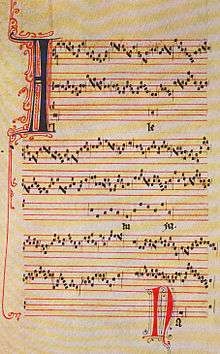Ars antiqua
Ars antiqua, also called ars veterum or ars vetus, is a term used by modern scholars to refer to the Medieval music of Europe during the high Middle Ages, between approximately 1170 and 1310. This covers the period of the Notre Dame school of polyphony (the use of multiple, simultaneous, independent melodic lines), and the subsequent years which saw the early development of the motet, a highly varied choral musical composition. Usually the term "ars antiqua" is restricted to sacred (church) or polyphonic music, excluding the secular (non-religious) monophonic songs of the troubadours, and trouvères. However sometimes the term "ars antiqua" is used more loosely to mean all European music of the thirteenth century, and from slightly before. The term ars antiqua is used in opposition to ars nova (meaning "new art", "new technique" or "new style"), which refers to the period of musical activity between approximately 1310 and 1375.
History

The original Middle Ages uses of the expression, found in the Speculum Musice of Jacobus and once by Johannes de Muris (the only one to use the exact term "ars antiqua"), referred specifically to the period of Franco of Cologne, approximately 1250 – 1310, but this restricted usage is rarely employed in modern scholarship. Almost all composers of the ars antiqua are anonymous. Léonin (fl. late 12th century), and Pérotin (fl. c.1180 – c.1220) were the two composers known by name from the Notre Dame school; in the subsequent period, Petrus de Cruce, a composer of motets, is one of the few whose name has been preserved.
In music theory the ars antiqua period saw several advances over previous practice, most of them in conception, and notation of rhythm. In the early Medieval music era, notation indicated the pitches of songs without indicating the rhythm that these notes should be sung in. The most famous music theorist of the first half of the 13th century, Johannes de Garlandia, was the author of the De Mensurabili Musica (about 1240), the treatise which defined, and most completely elucidated the rhythmic modes. A German theorist of a slightly later period, Franco of Cologne, was the first to describe a system of notation in which differently shaped notes have entirely different rhythmic values (in the Ars cantus mensurabilis of approximately 1280), an innovation which had a massive impact on the subsequent history of European music. Most of the surviving notated music of the 13th century uses the rhythmic modes as defined by Garlandia.
The early Gothic includes the French music composed in the Notre Dame school up until about 1260, and the high Gothic all the music between then, and about 1310 or 1320, the conventional beginning of the ars nova. The forms of organum and conductus reached their peak development in the early Gothic, and began to decline in the high Gothic, being replaced by the motet.
Though the style of the ars antiqua went out of fashion rather suddenly in the first two decades of the fourteenth century, it had a late defender in Jacques of Liège (alternatively known as Jacob of Liège), who wrote a violent attack on the "irreverent, and corrupt" ars nova in his Speculum Musicae (c.1320) vigorously defending the old style in a manner suggestive of any number of music critics from the Middle Ages to the present day (Jacobus 1955–73, book 7, passim). To Jacques, the ars antiqua was the musica modesta, and the ars nova was a musica lasciva—a kind of music which he considered to be excessively indulgent, capricious, immodest, and sensual (Anderson and Roesner 2001).
See also
References
- Anderson, Gordon A., and Edward H. Roesner. "Ars Antiqua [Ars Veterum, Ars Vetus]". The New Grove Dictionary of Music, and Musicians, edited by Stanley Sadie, and John Tyrrell. 29 vols. London: Macmillan Publishers, 2001. ISBN 1-56159-239-0.
- Jacobus of Liège. Speculum musicae, edited by Roger Bragard. Seven volumes in eight. Corpus scriptorum de musica 3. Rome: American Institute of Musicology, 1955–73.
Further reading
- Apel, Willi. The Notation of Polyphonic Music, 900-1600, fifth edition, revised, and with commentary. Publications of the Mediaeval Academy of America, no. 38. Cambridge, Mass.: Mediaeval Academy of America, 1961.
- . "Ars Antiqua". The New Grove Dictionary of Music, and Musicians, edited by Stanley Sadie. 20 vols. London, Macmillan Publishers Ltd., 1980. ISBN 1-56159-174-2.
- Franco of Cologne. "Ars cantus mensurabilis". English translation by Oliver Strunk in his Source Readings in Music History,. New York: W. W. Norton & Co., 1950.
- Gleason, Harold, and Warren Becker. Music in the Middle Ages, and the Renaissance, third edition. Music Literature Outlines, Series 1. Bloomington, Indiana: Frangipani Press, 1981. ISBN 0-89917-034-X.
- Hammond, Frederick, and Oliver B. Ellsworth. "Jacobus of Liège [Iacobus Leodiensis, ?Iacobus de Montibus, ?Iacobus de Oudenaerde, Jacques de Liège]". The New Grove Dictionary of Music, and Musicians, second edition, edited by Stanley Sadie, and John Tyrrell. London: Macmillan Publishers, 2001.
- Harne, George A. "The Ends of Theory, and Practice in the Speculum Musicae". Musica Disciplina 55 (2010): 5-31.
- Harne, George A. "Theory, and Practice in the Speculum Musicae". PhD diss. Princeton: Princeton University, 2008.
- Hentschel, Frank. "Der Streit um die ars nova: Nur ein Scherz?" Archiv für Musikwissenschaft 58, no. 2: 110–30.
- Hoppin, Richard H. Medieval Music. New York, W.W. Norton & Co., 1978. ISBN 0-393-09090-6
- Seay, Albert. "Musical Conservatism in the Fourteenth Century". In Something of Great Constancy: Essays in Honor of the Memory of J. Glenn Gray, 1913–1977, edited by Timothy Fuller, 144–57. Colorado Springs: Colorado College, 1979.
- Slocum, Kay Brainerd. 1987. "Speculum Musicae: Jacques de Liège, and the Medieval Vision of God". PhD diss. Kent, OH: Kent State University.
- Smith, F. Joseph." Jacques de Liège's Criticism of the Notational Innovations of the Ars nova". Journal of Musicological Research 4, nos. 3–4 (1983): 267–313.